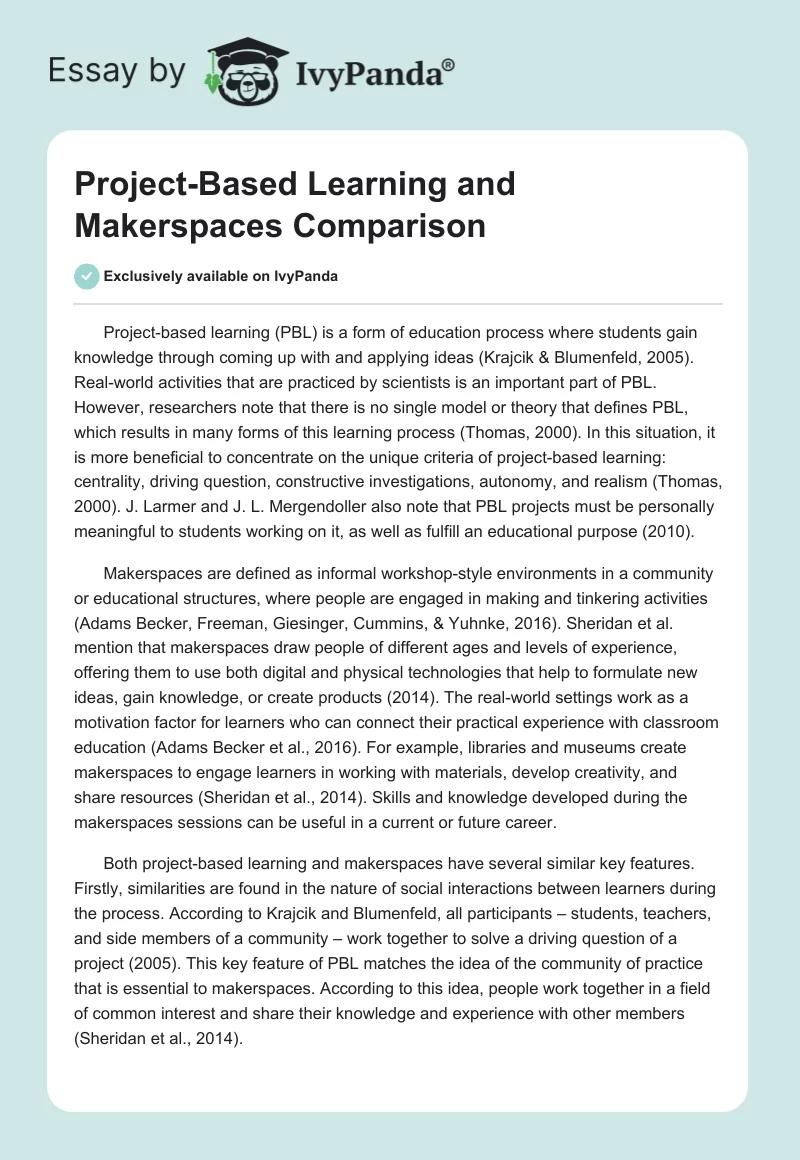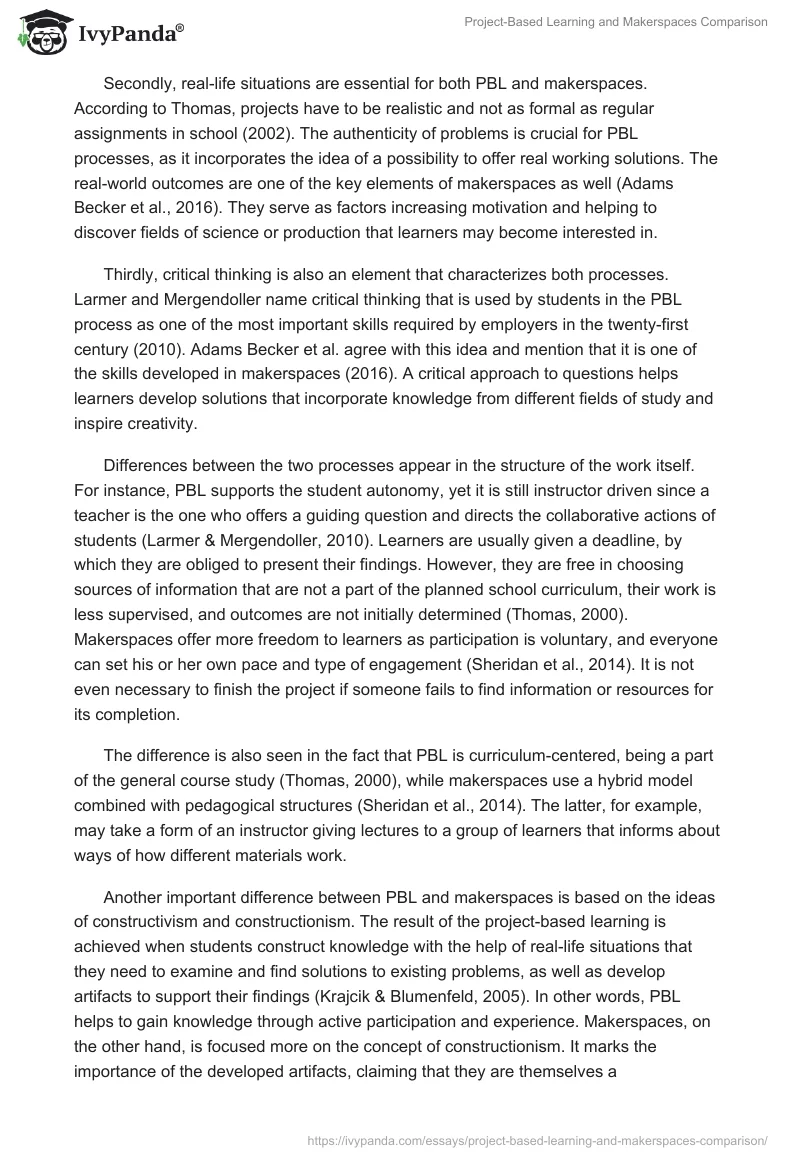Project-based learning (PBL) is a form of education process where students gain knowledge through coming up with and applying ideas (Krajcik & Blumenfeld, 2005). Real-world activities that are practiced by scientists is an important part of PBL. However, researchers note that there is no single model or theory that defines PBL, which results in many forms of this learning process (Thomas, 2000). In this situation, it is more beneficial to concentrate on the unique criteria of project-based learning: centrality, driving question, constructive investigations, autonomy, and realism (Thomas, 2000). J. Larmer and J. L. Mergendoller also note that PBL projects must be personally meaningful to students working on it, as well as fulfill an educational purpose (2010).
Makerspaces are defined as informal workshop-style environments in a community or educational structures, where people are engaged in making and tinkering activities (Adams Becker, Freeman, Giesinger, Cummins, & Yuhnke, 2016). Sheridan et al. mention that makerspaces draw people of different ages and levels of experience, offering them to use both digital and physical technologies that help to formulate new ideas, gain knowledge, or create products (2014). The real-world settings work as a motivation factor for learners who can connect their practical experience with classroom education (Adams Becker et al., 2016). For example, libraries and museums create makerspaces to engage learners in working with materials, develop creativity, and share resources (Sheridan et al., 2014). Skills and knowledge developed during the makerspaces sessions can be useful in a current or future career.
Both project-based learning and makerspaces have several similar key features. Firstly, similarities are found in the nature of social interactions between learners during the process. According to Krajcik and Blumenfeld, all participants – students, teachers, and side members of a community – work together to solve a driving question of a project (2005). This key feature of PBL matches the idea of the community of practice that is essential to makerspaces. According to this idea, people work together in a field of common interest and share their knowledge and experience with other members (Sheridan et al., 2014).
Secondly, real-life situations are essential for both PBL and makerspaces. According to Thomas, projects have to be realistic and not as formal as regular assignments in school (2002). The authenticity of problems is crucial for PBL processes, as it incorporates the idea of a possibility to offer real working solutions. The real-world outcomes are one of the key elements of makerspaces as well (Adams Becker et al., 2016). They serve as factors increasing motivation and helping to discover fields of science or production that learners may become interested in.
Thirdly, critical thinking is also an element that characterizes both processes. Larmer and Mergendoller name critical thinking that is used by students in the PBL process as one of the most important skills required by employers in the twenty-first century (2010). Adams Becker et al. agree with this idea and mention that it is one of the skills developed in makerspaces (2016). A critical approach to questions helps learners develop solutions that incorporate knowledge from different fields of study and inspire creativity.
Differences between the two processes appear in the structure of the work itself. For instance, PBL supports the student autonomy, yet it is still instructor driven since a teacher is the one who offers a guiding question and directs the collaborative actions of students (Larmer & Mergendoller, 2010). Learners are usually given a deadline, by which they are obliged to present their findings. However, they are free in choosing sources of information that are not a part of the planned school curriculum, their work is less supervised, and outcomes are not initially determined (Thomas, 2000). Makerspaces offer more freedom to learners as participation is voluntary, and everyone can set his or her own pace and type of engagement (Sheridan et al., 2014). It is not even necessary to finish the project if someone fails to find information or resources for its completion.
The difference is also seen in the fact that PBL is curriculum-centered, being a part of the general course study (Thomas, 2000), while makerspaces use a hybrid model combined with pedagogical structures (Sheridan et al., 2014). The latter, for example, may take a form of an instructor giving lectures to a group of learners that informs about ways of how different materials work.
Another important difference between PBL and makerspaces is based on the ideas of constructivism and constructionism. The result of the project-based learning is achieved when students construct knowledge with the help of real-life situations that they need to examine and find solutions to existing problems, as well as develop artifacts to support their findings (Krajcik & Blumenfeld, 2005). In other words, PBL helps to gain knowledge through active participation and experience. Makerspaces, on the other hand, is focused more on the concept of constructionism. It marks the importance of the developed artifacts, claiming that they are themselves a representation of participants’ knowledge received in the process (Sheridan et al., 2014). Finally, the use of technology is crucial for PBL, as it is a part of cognitive tools that deepen knowledge and help in performing tasks (Krajcik & Blumenfeld, 2005), while makerspaces incorporate a grand variety of actions not necessarily built around using technological elements.
The format of project-based learning seems to be very useful as a way of implementing my idea to teach students about the cycles of life. Krajcik and Blumenfeld mention that PBL has five key features, which follow one another and characterize every phase of the process (2005). These features include formulating a driving question, exploration, engagement in collaborative activities, using learning technologies, and creating tangible products.
The driving question that I would offer my students would sound as following: “How is it possible to organize a museum that would give an opportunity for its visitors to understand the theory behind the cycles of life in a creative and engaging way?” This driving question has to serve as an entry event and stimulate the learners’ need to know (Larmer & Mergendoller, 2010). These factors are important as they raise the interest in the topic and initiate the process of questioning among students.
The next step is an active exploration of the existing theory. The process of problem-solving must engage students in using concepts from their study disciplines (Krajcik & Blumenfeld, 2005). All students working on this project are to be divided into small groups, each of which must present its own findings as a team at the end. Students will be given freedom in choosing a plant or animal species that will serve as an example in explaining its life cycle. The means of control by an instructor will include the schedule of sharing the findings with the rest of the students, the form of testing gained knowledge, and the final organization of presenting the artifacts.
The third step of this project-based learning will include collaborative activities between the instructor and the students (Krajcik & Blumenfeld, 2005). Teams will share their findings with the class and present the information about the life cycles of their chosen animal or plant. This step is crucial since it allows us to receive feedback from peers about whether this way of presenting theoretical information sounds engaging to the common public. One of the terms stated in the driving question mentions that life cycle theory must be engaging to museum visitors. The collaborative action may stimulate further questioning, leaving students with a feeling that they are conducting a real-life inquiry (Larmer & Mergendoller, 2010).
The collaboration part of the project is one of the most important features of this PBL process. Krajcik and Blumenfeld (2005) note that communicating ideas to other group members leads to sharing unique practical experience and knowledge that some students may possess. Such a process of sharing information is more beneficial due to the wider scope of areas that it covers as compared to the formal study of the discipline, which is usually structured in more linearly.
The fourth step is built around students using technology for research and problem solving (Krajcik & Blumenfeld, 2005). The essence of the idea about cycles of life is based upon circuity which is best shown via graphic presentation. Schemes allow students to show connections between different stages of a species’ life cycle, its specifics at each point, and relations with other natural factors. Software technologies can be used for this purpose to create visual artifacts as final products of the PBL.
Finally, the last step is to create tangible products that serve as a solution to the problem (Krajcik & Blumenfeld, 2005). Project-based learning employs the concept of being led in a real-life situation structure, which means that outcome products must also be realistic. The possibility of artifacts to be implemented in real life as a working solution is one of the PBL’s key features (Thomas, 2000). The practical solution for this project about cycles of life will be put in a museum for the local community. While students will have a certain freedom of choosing the form of their final artifact, it will have to be either a multimedia presentation or a physical object that can potentially be put in a museum according to its technological and architectural possibilities.
Using project-based learning for this assignment is beneficial as it creates additional value for students. Their work becomes more meaningful since it is done not only for the teacher but also for their community (Larmer & Mergendoller, 2010). Students will be able to gain deeper knowledge about life cycles as they construct understanding by using various ideas and experiences from different fields (Krajcik & Blumenfeld, 2005).
References
Adams Becker S., Freeman, A., Giesinger Hall, C., Cummins, M., & Yuhnke, B. (2016). NMC/CoSN Horizon report: 2016 K-12 edition. Austin, TX: The New Media Consortium.
Krajcik, J. S., & Blumenfeld, P. C. (2005). Project-based learning. In R. K. Sayer (Ed.), The Cambridge handbook of the learning sciences (pp. 646-684). Cambridge, England: Cambridge University Press.
Larmer, J., & Mergendoller, J. R. (2010). 8 essentials for project-based learning. Educational leadership,68(1), 34-37.
Sheridan, K., Halverson, E. R., Litts, B., Brahms, L., Jacobs-Priebe, L., & Owens, T. (2014). Learning in the making: A comparative case study of three makerspaces. Harvard Educational Review, 84(4), 505-531.
Thomas, J. W. (2000). A review of research on project-based learning. San Rafael, CA: Autodesk.


